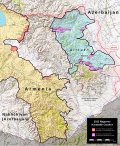Search results
Appearance
There is a page named "Kalbajar District" on Wikipedia
- Kalbajar District (Azerbaijani: Kəlbəcər rayonu) is one of the 66 districts of Azerbaijan. It is located in the west of the country and belongs to the...18 KB (1,665 words) - 12:28, 29 April 2024
- Kalbajar (Azerbaijani: Kəlbəcər (listen); Armenian: Քարվաճառ, romanized: Karvachar) is a city and the capital of the Kalbajar District of Azerbaijan. Located...23 KB (2,021 words) - 18:36, 2 July 2024
- Battle of Kalbajar took place in March and April 1993, during the First Nagorno-Karabakh War. It resulted in the capture of the Kalbajar District of Azerbaijan...30 KB (3,354 words) - 02:54, 20 February 2024
- Shahumyan Province (section Shahumyan district)Goygol and Goranboy districts of Azerbaijan to the north. The western part of the province, corresponding to the Kalbajar District of Azerbaijan, was controlled...13 KB (988 words) - 08:18, 26 March 2024
- 2014 Kalbajar incident refers to the crossing of a small group of Azerbaijanis into Kalbajar district, their subsequent capture and conviction for murder...17 KB (1,958 words) - 15:00, 20 February 2024
- 7 occupied districts of Azerbaijan)Armenian forces launched an offensive in Kalbajar and by 5 April had completely occupied the area of Kalbajar District, creating a strong link between Nagorno...79 KB (5,709 words) - 12:10, 18 June 2024İstisu (Istisu, lit. 'warm water' in Azerbaijani) is a village in the Kalbajar District of Azerbaijan. Situated in a river valley, Istisu has historically...3 KB (231 words) - 01:36, 29 June 2024Qılınclı (Gilinjli) is a village in the Kalbajar District of Azerbaijan. The village was located in the Armenian-occupied territories surrounding Nagorno-Karabakh...3 KB (173 words) - 01:41, 29 June 2024of Armenia shall return the Kalbajar District to the Republic of Azerbaijan by November 15, 2020, and the Lachin District by December 1, 2020. The Lachin...66 KB (5,720 words) - 11:41, 9 April 2024
- 26611°E / 39.99500; 46.26611 Ağzıbir (Aghzibir) was a village in the Kalbajar District of Azerbaijan. Ağzıbir, Kalbajar at GEOnet Names Server v t e...1 KB (38 words) - 01:32, 29 June 2024
- / 40.13278; 46.12306 Bashkend (Azerbaijani: Başkənd) is a village in the Kalbajar Rayon of Azerbaijan. Bashkend, Kalbajar at GEOnet Names Server v t e...1 KB (39 words) - 20:08, 29 June 2024
- also occupied the surrounding Azerbaijani-populated districts of Agdam, Jabrayil, Fuzuli, Kalbajar, Qubadli, Lachin and Zangilan. The terms of the Bishkek...224 KB (19,345 words) - 02:15, 22 June 2024
- begins in the Karabakh Plateau, in the Kalbajar District and continues through the Aghdam, Tartar and Barda District. It enters the Kura on the right. Khachinchay...3 KB (138 words) - 14:52, 30 June 2024
- 167°N 46.083°E / 40.167; 46.083 Xaçkənd (Khachkend) was a village in the Kalbajar District of Azerbaijan. Xaçkənd, Kalbajar at GEOnet Names Server v t e...1 KB (36 words) - 01:44, 29 June 2024
- recapture the district of Kalbajar in the final stage of the First Nagorno-Karabakh War. Armenian forces had captured the entire district in an offensive...51 KB (5,180 words) - 18:06, 1 June 2024
- belonging to the East Zangezur Economic Region. The district borders the districts of Kalbajar, Khojaly, Shusha, Khojavend, Qubadli, and the Syunik Province...10 KB (955 words) - 19:14, 19 May 2024
- its soldiers was killed by an Armenian army sniper in Aşağı Ayrım, Kalbajar District, which Armenia immediately denied. On 2 October, Armenia accused Azerbaijani...250 KB (20,721 words) - 17:58, 12 June 2024
- 133°E / 40.267; 46.133 Qaradağlı (Garadaghly) is a village in the Kalbajar District of Azerbaijan. It is suspected that this village has undergone a name...1 KB (60 words) - 01:40, 29 June 2024
- Aghjakand (Azerbaijani: Ağcakənd) is a village in the Kalbajar District of Azerbaijan. The village was occupied by Armenian forces during the First Nagorno-Karabakh...2 KB (87 words) - 19:54, 29 June 2024
- Nagorno-Karabakh region with the city of Shusha and 7 adjacent districts - Lachin. Kalbajar, Aghdam, Jabrayil, Fuzuli, Qubadly, Zangilan have been occupied












